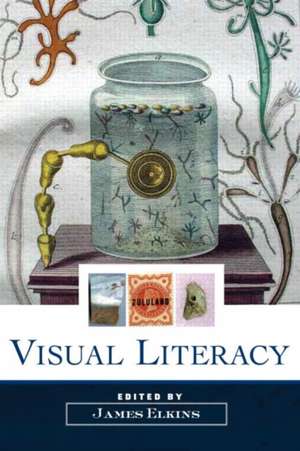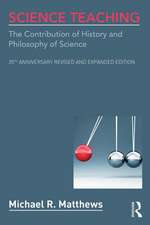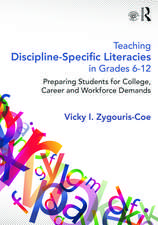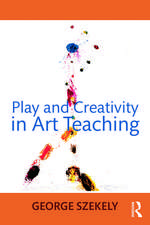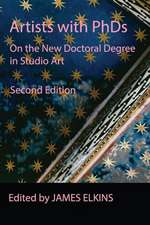Visual Literacy
Editat de James Elkinsen Limba Engleză Paperback – 11 oct 2007
Contributors: Matthias Bruhn, Vera Dünkel, Jonathan Crary, Christopher Crouch, Peter Dallow, James Elkins, Henrik Enquist, W.J.T. Mitchell, Richard K. Sherwin, Susan Shifrin, Jon Simons, Barbara Maria Stafford, William Washabaugh
| Toate formatele și edițiile | Preț | Express |
|---|---|---|
| Paperback (1) | 399.87 lei 43-57 zile | |
| Taylor & Francis – 11 oct 2007 | 399.87 lei 43-57 zile | |
| Hardback (1) | 1110.92 lei 43-57 zile | |
| Taylor & Francis – 18 oct 2007 | 1110.92 lei 43-57 zile |
Preț: 399.87 lei
Nou
Puncte Express: 600
Preț estimativ în valută:
76.51€ • 80.10$ • 63.31£
76.51€ • 80.10$ • 63.31£
Carte tipărită la comandă
Livrare economică 07-21 aprilie
Preluare comenzi: 021 569.72.76
Specificații
ISBN-13: 9780415958110
ISBN-10: 0415958113
Pagini: 228
Ilustrații: 40 black & white illustrations
Dimensiuni: 152 x 229 x 15 mm
Greutate: 0.7 kg
Ediția:1
Editura: Taylor & Francis
Colecția Routledge
Locul publicării:Oxford, United Kingdom
ISBN-10: 0415958113
Pagini: 228
Ilustrații: 40 black & white illustrations
Dimensiuni: 152 x 229 x 15 mm
Greutate: 0.7 kg
Ediția:1
Editura: Taylor & Francis
Colecția Routledge
Locul publicării:Oxford, United Kingdom
Public țintă
General, Postgraduate, and UndergraduateCuprins
Introduction: The Concept of Visual Literacy, and Its Limitations, James Elkins
1. Visual Literacy, W.J.T. Mitchell
2. The Remaining 10%: The Role of Sensory Knowledge in the Age of the Self-Organizing Brain, Barbara Stafford
3. Nineteenth-Century Visual Incapacities, Jonathan Crary
4. From Visual Literacy to Image Competence, Jon Simons
5. The Visual Complex: Mapping Some Interdisciplinary Dimensions Of Visual Literacy, Peter Dallow
6. Visual Literacy in North American Secondary Schools, Susan Shifrin
7. Philosophical Bases for Visual Multiculturalism at the College Level, William Washabaugh
8. Bridging the Gap Between Clinical and Patient-Provided Images, Henrik Enquist
9. Visual Literacy in Action: Law in the Age of Images, Richard Sherwin
10. The Image as Cultural Technology, Matthias Bruhn and Vera Dünkel
Afterword, Christopher Crouch
1. Visual Literacy, W.J.T. Mitchell
2. The Remaining 10%: The Role of Sensory Knowledge in the Age of the Self-Organizing Brain, Barbara Stafford
3. Nineteenth-Century Visual Incapacities, Jonathan Crary
4. From Visual Literacy to Image Competence, Jon Simons
5. The Visual Complex: Mapping Some Interdisciplinary Dimensions Of Visual Literacy, Peter Dallow
6. Visual Literacy in North American Secondary Schools, Susan Shifrin
7. Philosophical Bases for Visual Multiculturalism at the College Level, William Washabaugh
8. Bridging the Gap Between Clinical and Patient-Provided Images, Henrik Enquist
9. Visual Literacy in Action: Law in the Age of Images, Richard Sherwin
10. The Image as Cultural Technology, Matthias Bruhn and Vera Dünkel
Afterword, Christopher Crouch
Recenzii
"Visual Literacy brings intellectual rigor to a concept that often passes as an unexamined cliché. This collection of essays explores how well the metaphor of ‘reading’ elucidates the viewing and interpretation of images, whether artistic, political, or scientific. The volume will find its place on the bookshelves of both serious scholars of vision and instructors who rise to the challenge of integrating diverse visual artifacts into the undergraduate curriculum."—James D. Herbert, University of California, Irvine
"Given that much university education is dominantly and sometimes entirely text-based, the central issue of whether there can and ought to be a stronger emphasis on the visual is a valuable, challenging, perhaps even threatening one, for denizens of academia."--Margaret Woodward, Eureka Street
"Given that much university education is dominantly and sometimes entirely text-based, the central issue of whether there can and ought to be a stronger emphasis on the visual is a valuable, challenging, perhaps even threatening one, for denizens of academia."--Margaret Woodward, Eureka Street
Notă biografică
James Elkins is E.C. Chadbourne Chair in the Department of Art History, Theory, and Criticism at the School of the Art Institute of Chicago. He is the author of Pictures and Tears, How to Use Your Eyes, and What Painting Is and, most recently, The Strange Place of Religion in Contemporary Art and Master Narratives and Their Discontents, all published by Routledge.
Descriere
What does it mean to be visually literate? Does it mean different things in the arts and the sciences? In the developed West or in developing nations? This groundbreaking collection explores what impact the new concept of "visual literacy" has on art history.
